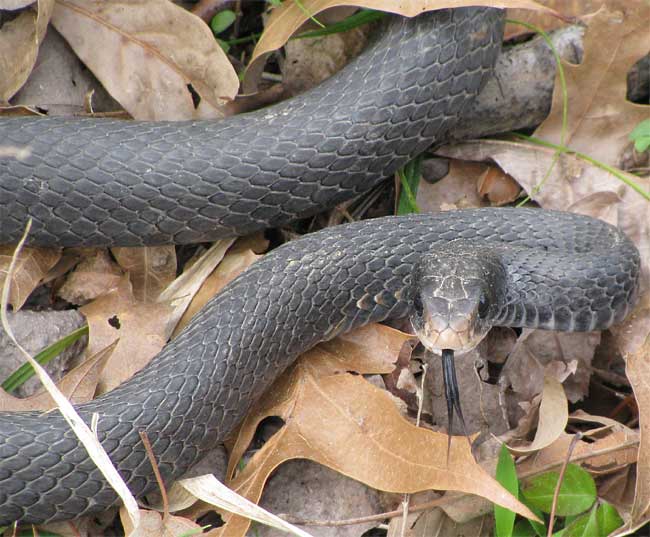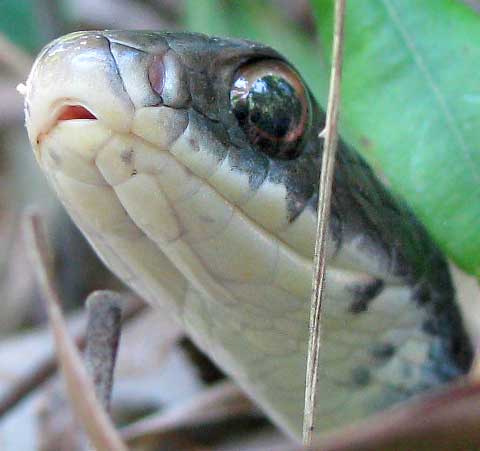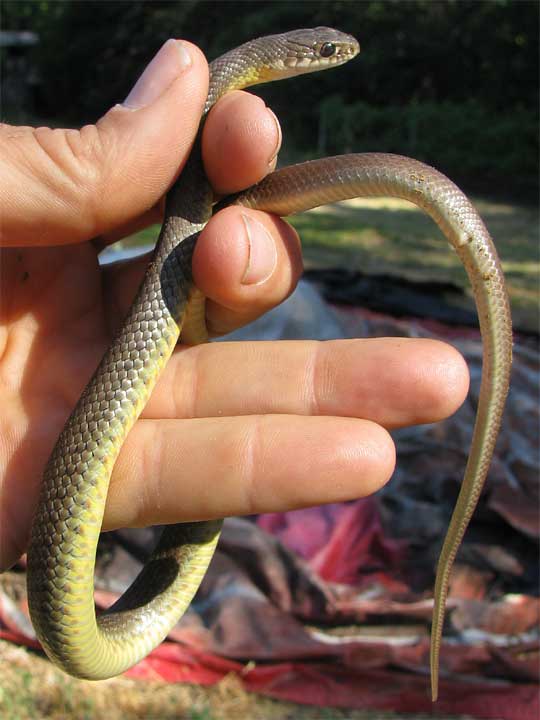Excerpts from Jim Conrad's
Naturalist Newsletter

from the March 16, 2009 Newsletter, issued from the forest near Natchez, Mississippi; elevation ~400ft (120m), ~N31.42°,&nsp;~W91.41°:
RACERS HAVE EMERGED
I didn't realize I'd stepped on or come close to stepping on the poor snake until he began writhing in dry leaves below me. By the time I realized it was a snake I was already airborne well beyond striking distance, even though a glimpse told me it wasn't a venomous species. It was a Southern Black Racer, COLUBER CONSTRICTOR ssp. PRIAPUS, and you can see him above.
Racers aren't venomous but they do aggressively defend themselves. I toyed with the idea of holding his head down with a stick as I grabbed him behind the neck for a close-up, but he'd have nothing of that, striking at the stick before I could get it near him. I just let him lie, which I should have done from the beginning.
One feature making this a racer instead of, say, a rat snake, is its smooth scales. Scales on rat snakes display a very narrow, low ridge running lengthwise, and are said to be "weakly keeled." You can see that this racer's diamond-shaped scales don't have a hint of a keel. Also, racers are slender, as snakes go.
from the June 30, 2008 Newsletter, issued from the forest near Natchez, Mississippi; elevation ~400ft (120m), ~N31.47°, ~W91.29°:
A RACER UP CLOSE
The other day Karen once again let out her there's-a-snake whoop and once again I grabbed my camera and went running. This time it was a Southern Black Racer, COLUBER CONSTRICTOR ssp. PRIAPUS, with his head held high. I got onto my elbows and knees and inched closer and closer until I got the head-shot shown below:

This time while identifying it I paid special attention to those facial scales by comparing them with snake-head images on the Internet, and was sure it was a Southern Black Racer.
Our Southern subspecies is similar to the Northern subspecies, the main difference being that the Northern's upper lip scales are black, with white being restricted to its chin. As you can see, the upper lip scales of ours bear a lot of white. My Audubon field guide reports the Northern's eye iris as being brown, while irises of our Southern subspecies are usually red or orange. I'm not sure how I'd call the iris of the snake in my picture. On the University of Texas page the Eastern Yellow-bellied Racer subspecies is represented, which is light gray above and yellow below. The Audubon guide describes eleven Racer subspecies for North America.
An interesting feature of my photo is that it appears to show two elongate pouches below the snake's mouth where fangs might rest when the snake's mouth is closed. You can almost make out the fangs pressing against the throat's floor. The problem with that is that colubrids such as racers don't have long fangs. They have teeth but nothing like a rattler's long fangs.
from the August 24, 2003 Newsletter, issued from near Natchez, Mississippi:
BLACK RACER EATS FROG
Walking down Cooper Branch's dry, sandy bed, a flicker of movement caught my attention at the corner of my vision. I looked up just in time to see a tangle of frog legs and loopy, black snake-coils rolling down the creek bank like a rubbery tumbleweed. I'm only half sure the victim was a Southern Leopard Frog, for most of its body already was inside the snake's mouth and throat, with just its flailing legs and head showing. The snake's identity was clear, however: It was a Southern Black Racer, COLUBER CONSTRICTOR PRIAPUS.
On the streambed's sandy floor there was still some fighting to do. The frog's four powerful legs scratched, pounded, pushed, and held on in every conceivable manner to slow the body's slide down the snake's gullet. The snake, in turn, with no limbs at all, could only try to hold on. Racers possess only regular teeth in both jaws, with no enlarged fangs with which to stab into their prey, so sometimes it looked as if the frog might succeed.
However, after about five minutes the frog tired and blood issued from its nostrils. Sensing victory, the snake made a series of forward lunges, each advance taking the frog deeper inside. In the end only one arm -- unnervingly like a small human arm bent at the elbow and with fingers spread wide in alarm -- poked from the snake's mouth corner. Then even that vanished.
The racer hardly missed a beat. As soon as the meal was definitely inside, instantly the search for the next victim began as the snake moved back to the overgrown slope and disappeared inside it.
Something special about racers is that, when they hunt, the back 3/4ths of their bodies move across the ground while the front quarter rises vertically, with their heads at the top hooked forward and held horizontally. Thus, when we see them, usually the snake's back part is hidden in the grass while the front, high-held part with the hooked head seems to progress forward by no visible means of propulsion. Such a snake with its unblinking eyes' fixed forward makes a majestic, spine-tingling passage through tall grass.
from the June 1, 2006 Newsletter, issued from Polly's Bend, Garrard County, Kentucky
RACER IN A MOLE TUNNEL
This is turning into a pretty good place for snakes. Sunday afternoon I stepped from the porch and not ten feet away lay a six-foot, black, slender snake. It was a Racer, sometimes called Black Racer, COLUBER CONSTRICTOR. I was surprised both that he was lying still in such an exposed spot, and that he hadn't streaked away when I'd appeared. Then I saw that the snake's vision had been blocked from seeing me by a curled leaf on the ground.
Now he began circling in a ten-ft-wide part of the lawn, occasionally lifting his front end while keeping his head horizontal, cobra-like. Sometimes when Racers travel with their heads raised like this, with grass hiding their bodies so you just see what looks like an upside-down L moving past, it's kind of spooky.
From time to time the circling snake would more or less point his head into the dirt, screw it around as if he were trying to force his way into the ground, and then he'd move elsewhere. After about five minutes of such maneuvering I was astonished to see that now he really did enter the soil. I moved near him and saw that the ground he'd entered was crumbly and mounded up. He'd found a mole's tunnel and now was entering it. After a minute or so the snake disappeared completely underground. I went and sat cross-legged about a yard away.
About five minutes later he began backing out, tail first. I couldn't see a bulge in his materializing body signifying a swallowed mole, so his hunt must have been unsuccessful.
Outside the tunnel the snake raised his head to that upside-down L and began moving right at me. I wanted to remain invisible to him, so I didn't move at all. His head got to about six inches from my knee and he stopped, flicking his tongue smelling the air, seeming to be gathering the impression that something was amiss, but apparently not dangerous. He looked right at my knee for a good 30 seconds before turning around and slowly making his way into the weeds.
It's surprising how impressive a six-ft-long snake is when his head is six inches from your knee. Of course Racers aren't venomous, but they are known to be good biters if cornered. The thought crossed my mind that it would be nice if lately I hadn't been kneeling atop a mole tunnel, giving my knee a rodent odor.
from the July 26, 2009 Newsletter, from near Cave Junction, California:
RACER IN A COMPOST HEAP
Upon leaving the wilderness area, first we passed by my friends' home. They'd told me that beneath the plastic sheet covering one of their compost heaps usually a racer (snake) hung out, so we went to check him out. You can see the little snake below:

That's a young Western Yellow-bellied Racer, COLUBER CONSTRICTOR ssp. MORMON. In earlier Newsletters we've seen other subspecies, and already noted that several subspecies who vary considerably in coloration are recognized; my old Audubon guide lists eleven for North America. Racers occur from the US East Coast all the way to the Pacific, though not in much of the desert Southwest and the north-central states. Oregon's Yellow-bellied subspecies can be found from southern British Columbia to Mexico's Baja California, east to southwestern Montana and western Colorado.